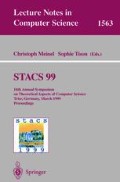Abstract
In this paper, a simple technique which unifies the known approaches for proving lower bound results on the size of deterministic, nondeterministic, and randomized OBDDs and kOBDDs is described.
This technique is applied to establish a generic lower bound on the size of randomized OBDDs with bounded error for the so-called “k-stable” functions which have been studied in the literature on read-once branching programs and OBDDs for a long time. It follows by our result that several standard functions are not contained in the analog of the class BPP for OBDDs.
It is well-known that k-stable functions are hard for deterministic read-once branching programs. Nevertheless, there is no generic lower bound on the size of randomized read-once branching programs for these functions as for OBDDs. This is proven by presenting a randomized read-once branching program of polynomial size, even with zero error, for a certain k-stable function. As a consequence, we obtain that P ⊂≠ ZPP ∩ NP ∩ coNP for the analogs of these classes defined in terms of the size of read-once branching programs.
This work has been supported by DFG grant We 1066/8-1.
Access this chapter
Tax calculation will be finalised at checkout
Purchases are for personal use only
Preview
Unable to display preview. Download preview PDF.
References
F. Ablayev. Randomization and nondeterminism are incomparable for polynomial ordered binary decision diagrams. In Proc. of 24th ICALP, LNCS 1256, 195–202. Springer, 1997.
F. Ablayev and M. Karpinski. On the power of randomized branching programs. In Proc. of 23rd ICALP, LNCS 1099, 348–356. Springer, 1996.
F. Ablayev and M. Karpinski. On the power of randomized ordered branching programs. TR98-004, Electr. Coll. on Computational Complexity, 1998.
M. Agrawal and T. Thierauf. The satisfiability problem for probabilistic ordered branching programs. In Proc. of the 13th IEEE Int. Conf. on Computational Complexity, 81–90, 1998.
B. Bollig, M. Sauerhoff, D. Sieling, and I. Wegener. Hierarchy theorems for kOBDDs and kIBDDs. Theoretical Computer Science, 205(1):45–60, 1998.
Y. Breitbart, H. Hunt III, and D. Rosenkrantz. On the size of binary decision diagrams representing Boolean functions. Theoretical Computer Science, 145:45–69, 1995.
R. E. Bryant. Graph-based algorithms for Boolean function manipulation. IEEE Trans. Computers, C-35(8):677–691, Aug. 1986.
R. E. Bryant. On the complexity of VLSI implementations and graph representations of Boolean functions with application to integer multiplication. IEEE Trans. Computers, C-40(2):205–213, Feb. 1991.
P. E. Dunne. Lower bounds on the complexity of 1-time only branching programs. In Proc. of FCT, LNCS 199, 90–99. Springer, 1984.
P. Duris, J. Hromkovic, J. D. P. Rolim, and G. Schnitger. Las Vegas versus determinism for one-way communication complexity, finite automata, and polynomial-time computations. In Proc. of 14th STACS, LNCS 1200, 117–128. Springer, 1997. To appear in Information and Computation.
J. Gergov. Time-space tradeoffs for integer multiplication on various types of input oblivious sequential machines. Information Processing Letters, 51:265–269, 1994.
J. Hromkovic. Communication Complexity and Parallel Computing. Springer, Berlin, 1997.
J. Hromkovic. Communication complexity and lower bounds on multilective computations. In Proc. of 23rd MFCS, LNCS 1450, 789–797. Springer, 1998.
J. Jain, J. Bitner, M. S. Abadir, J. A. Abraham, and D. S. Fussell. Indexed BDDs: Algorithmic advances in techniques to represent and verify Boolean functions. IEEE Trans. Computers, 46:1230–1245, 1997.
S. Jukna, A. Razborov, P. Savický, and I. Wegener. On P versus NP ∩ co-NP for decision trees and read-once branching programs. In Proc. of 22nd MFCS, LNCS 1295, 319–326. Springer, 1997. To appear in Computational Complexity.
S. P. Jukna. Lower bounds on communication complexity. Mathematical Logic and Its Applications, 5:22–30, 1987.
S. P. Jukna. Entropy of contact circuits and lower bounds on their complexity. Theoretical Computer Science, 57:113–129, 1988.
M. Karpinski. On the computation power of randomized branching programs. In Randomized Algorithms, Proc. of the International Workshop, 1–12, Brno, 1998.
M. Karpinski and R. Mubarakzjanov. A note on Las Vegas OBDDs. Manuscript, Nov. 1998.
M. Krause. Exponential lower bounds on the complexity of local and real-time branching programs. Journal of Information Processing and Cybernetics, EIK, 24(3):99–110, 1988.
M. Krause. Lower bounds for depth-restricted branching programs. Information and Computation, 91(1): 1–14, Mar. 1991.
I. Kremer, N. Nisan, and D. Ron. On randomized one-round communication complexity. In Proc. of 27th STOC, 596–605, 1995.
E. Kushilevitz and N. Nisan. Communication Complexity. Cambridge University Press, Cambridge, 1997.
M. Sauerhoff. A lower bound for randomized read-k-times branching programs. TR97-019, Electr. Coll. on Computational Complexity, 1997.
M. Sauerhoff. Lower bounds for randomized read-k-times branching programs. In Proc. of 15th STACS, LNCS 1373, 105–115. Springer, 1998.
D. Sieling and I. Wegener. Graph driven BDDs—a new data structure for Boolean functions. Theoretical Computer Science, 141:283–310, 1995.
I. Wegener. On the complexity of branching programs and decision trees for clique functions. Journal of the ACM, 35(2):461–471, Apr. 1988.
Author information
Authors and Affiliations
Editor information
Editors and Affiliations
Rights and permissions
Copyright information
© 1999 Springer-Verlag Berlin Heidelberg
About this paper
Cite this paper
Sauerhoff, M. (1999). On the Size of Randomized OBDDs and Read-Once Branching Programs for k-Stable Functions. In: Meinel, C., Tison, S. (eds) STACS 99. STACS 1999. Lecture Notes in Computer Science, vol 1563. Springer, Berlin, Heidelberg. https://doi.org/10.1007/3-540-49116-3_46
Download citation
DOI: https://doi.org/10.1007/3-540-49116-3_46
Published:
Publisher Name: Springer, Berlin, Heidelberg
Print ISBN: 978-3-540-65691-3
Online ISBN: 978-3-540-49116-3
eBook Packages: Springer Book Archive

